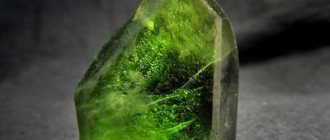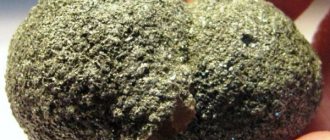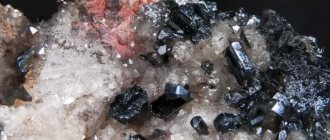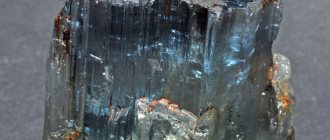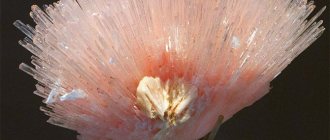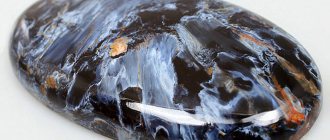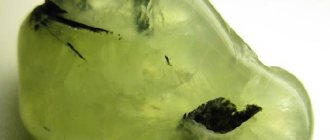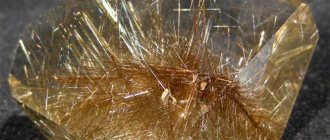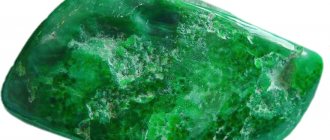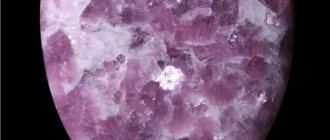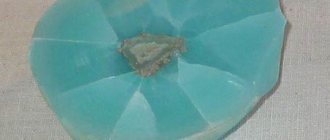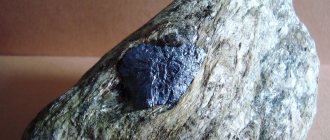The name cuprite comes from the Latin cuprum “cuprum” - copper; chalcotrichite - from the Greek "chalkos" - copper and "trix" - hair
The English name of the mineral Cuprite is Cuprite
Synonyms:
Cuprous oxide, red copper ore - red copper ore, ruby copper ore, Rothkupfererz, red copper - Rothkupfer (Agricola, 1546), ruby copper - ruby copper, octahedral copper ore - octahedral copper ore (Hil, 1771), red copper glass - Rothkupferglas (Pallas, 1793), copper glass - Kupferglas. Vanadium ocher - vanadic ochre (Teschemacher, 1851) from Lake Superior turned out to be cuprite (Shaler, 1915). Liver copper ore - Kupferlebererz (Kronstedt, 1758), liver ore - liver-ore, Hepatinerz, brick copper ore - Kupferziegelerz, brick ore, tile ore - Ziegelerz (Werner, 1817), tile ore, zigueline (Vedan, 1832) , ruberite - ruberite (Chapman, 1843) - earthy brick-red or reddish-brown mixtures of cuprite with minerals of the group of hydrous iron oxides, sometimes with an admixture of clay minerals, bronze ore - a mixture of earthy cuprite with native copper.
Feathery copper ore - Kupferfedererz (Emerliig, 1796), plush copper ore - plush copper ore, copper flowers - Kupferbliithe (Breithaupt, 1823).
Chemical composition
Chemical theoretical composition: Cu2O - 100 (Cu - 88.82). Traces of Se, J, and also Al, Fe, Si, Pb, etc. were noted, obviously due to the presence of impurities. In one sample of cuprite from Tsumeb, Ge was found to be 0.00005-0.0005%, in cuprite from Central Kazakhstan up to 0.001% In. Cuprite from Popelek (Czech Republic) has an increased content of V. Cuprites from the Zolotushinsky and Nizhne-Lazursky deposits (Altai Territory) contain traces of Cd, Sn, Bi. Composition of cuprite from the Zolotushinsky deposit: Cu2O - 98.08; MgO - traces; CaO - 0.14; ZnO - 0.27; PbO - 0.14 Al2O3 - 0.35; Fe2O3 - 0.61; SiO2 - 0.35; amount - 99.94. Cuprite from Rudabany (Hungary) contains 88.62% Cu.
Practical use
Medicinal properties
First of all, cuprite, thanks to its components, has a positive effect on the hematopoietic system. Traditional medicine uses it to normalize the menstrual cycle and reduce pain during it. Some nationalities are confident in the stone’s ability to help people with various addictions. Regular wearing allows you to get rid of not only drug or alcohol addiction, but also cope with addictions to fatty foods or the computer. It has also been noted that athletes who wear it as a talisman improve their results, since cuprite gives endurance and increases muscle tone.
Magical influence
Bioenergy therapists advise wearing the stone to people who by nature do not know how to cope with emotions. Because the energy of the mineral has a beneficial effect on the nervous system. Hot-tempered and unbalanced people after some time become pleasant interlocutors and successful, sociable employees.
But wearing it frequently can reduce a person’s intellectual level. Wearing jewelry is recommended only for honest and decent people, otherwise the owner of the stone will feel uncomfortable, and the reason may be in the energy of cuprite.
It is worth noting the unique properties of the mineral to attract good luck and success to its owner. It is important for people who have achieved their goals with its help not to forget about those in need and constantly help them. Thus, the stone will help the owner to reveal talents and achieve heights.
Influence on various zodiac signs
Cuprite is considered an inventive mineral, worn by people under the influence of the element of Fire, and only on the waning Moon. It is worth noting that this is one of the few stones that is not suitable for making a talisman.
Varieties
Chalcotrichite - chalcotrichite (Glocker, 1839) - hair-like and needle-like discharge. Typical deposits: Pervo-Uralskoye (Sverdlovsk region), Dzhezkazgan (Kazakhstan), Clifton and Morenci in the state. Arizona (USA). Hydrocuprite (Ghent, 1785) is a cryptocrystalline chalcotrichite containing some water. Color orange-red, yellow-orange. Gives a powderogram of cuprite. Possibly formed from Cu2O gel. Found in pcs. Pennsylvania (USA), in Baden (Germany), etc.
Applications for cuprite
Cuprites are often mined together with accompanying minerals such as malachite and azurite, and the resulting aggregates are cabochon cut and then used as an ornamental stone.
Crystalline cuprites of high jewelry quality are found in deposits quite rarely. Beautiful cuprites are now mined in Africa, but these samples cannot always withstand processing. Due to their high fragility, they can split or crack even after they have been inserted into jewelry.
Due to the low hardness, cuprite inserts quickly lose their original appearance. Therefore, they are practically not used as decorations for every day, but they can decorate any mineralogical collection and become its real highlight.
Crystallographic characteristics
Syngony . Cubic. 3L44L36L29PC
Symmetry class . Hexaoctahedral.
Crystal structure. Cuprite lattice. O atoms are located at the vertices and in the center of the cell, Cu atoms are located at the vertices of the tetrahedron formed by half of the octant centers of the cell. The Cu atom is surrounded by two O, the O atom by four Cu.
The most common forms are o (111), d (110), a (100), also n (211), p (221) and e (210).
Properties of the mineral
Cuprite crystals are distinguished by their rhomboid or cubic shape
. In deposits, the mineral is found in the form of earthy masses or granular growths. The size of one cuprite crystal is rarely more than three centimeters, but in world collections you can find mineralogical rarities with a mass of two kilograms. Almost all crystals of the mineral are defective; intergrowths, ingrowths and growths can often be observed.
The pure mineral is very bright, red to scarlet. The color of the stone is muted by impurities, so the crystals are reddish-brown, red-gray, or less often almost black with a barely detectable redness. The polished mineral shines like a diamond.
Form of being in nature
The appearance of crystals. Crystals of octahedral, dodecahedral or cubic appearance, often distorted; needle-shaped and fibrous chalcotrichite crystals are elongated along [0011]. Crystals of skeletal development are observed; There is often shading on the edges (rib shapes, according to Shafraiovsky). Oriented intergrowths with native copper, as well as oriented growths of cuprite on crystals of native copper and cuprite, were noted; Regular intergrowths of cuprite with chalcopyrite have been established.
In fibrous cuprite, formed by replacing antlerite, the location of the axes of cuprite fibers is noted almost along [111] of antlerite (deviation up to 10-15°); oriented intergrowths with buttgenbachite and connellite were also established, the needles of which are parallel to the edge (111) : (110) of cuprite; the decomposition products of covellite indicated the location of (111) cuprite parallel to (0001) covellite.
Aggregates . The crystals are usually small (rarely up to 3 cm across), granular and earthy aggregates, often porous, hair-like and needle-like secretions.
Types of cuprite
Depending on the shape and composition, several subspecies of cuprite are distinguished, including:
- Brick ore is a mixture of cuprites and limonites.
- Copper flowers are intergrowths with a tangled fibrous structure or needle-shaped crystals.
- Chalcotrichite - elongated, needle-shaped or hairy crystals of cuprite.
Physical properties
Optical
- The color is red, of various shades (mostly brown), lead-gray to almost black (chalcotrichite - carmine red).
- The streak is red to brown-red, shiny; with additional abrasion it becomes yellowish and then greenish and green.
- Diamond, semi-metallic luster.
- Matte shimmer
- Transparency. In thin fragments it is translucent, while in earthy fragments it is opaque.
Mechanical
- Hardness 3.5 - 4, microhardness 206 kg/mm2. Fragile.
- Density 5.8-6.2.
- Cleavage according to (111) is clear, rare according to (100).
- The fracture is conchoidal and uneven.
Cuprite colors
Pure cuprite crystals are colored bright scarlet.
Due to the presence of various impurities, this color of the stone is rare; it is usually more muted and expressed in shades of red-gray, reddish-brown. There are even almost black specimens with barely pronounced red highlights. Moreover, after polishing, cuprite sparkles like a diamond. Unfortunately, such an unusually beautiful color of the gem is unstable. When heated and exposed to bright sunlight for a long time, its intensity decreases, the shine disappears, or the stone even fades.
Chemical properties
Soluble in HCl; the concentrated solution, after cooling and diluting with cold water, gives an abundant white precipitate of CuCl2. Also soluble in NH4OH, in concentrated solutions of NaOH, HNO3, H3PO4 and H2SO4. In polished sections it is etched with aqua regia; boils with HNO3, a precipitate of metallic copper appears, and tarnishes from HNO3 vapors; from HCl it quickly turns brown, a coating forms, white under oblique lighting; from KCN it darkens, the structure is revealed; from FeCl3 it becomes dull and iridescent; HgCl2 and KOH have no effect. For structural etching, diluted HNO3 is used.
Other properties
Sometimes it has piezoelectric properties. Non-conductive. Some cuprites fluoresce dark crimson in cathode rays. The melting point of Cu2O is 1235°.
Therapeutic effect
The influence of the mineral is manifested physically and emotionally:
- Blood conditions are normalized: coagulation, hemoglobin level.
- It is important as a lady's healer, relieving the condition during menstruation.
The stone helps to overcome addictions of any kind: alcoholism, drug addiction, smoking. Useful for avid gamblers and shopaholics.
It is also suitable for people who are often nervous, unable to control emotions, get tired easily, or suffer from cramps.
Artificial production of cuprite
Cuprite can be easily obtained by calcining metallic copper in air, by alloying metallic copper with copper sulfate or copper oxide with copper chloride, by reduction in an alkaline solution, pyrolysis of a solution saturated with acetic acid or formic acid divalent copper, etc. During crystallization experiments in autoclaves (filled to 65-80%) by the method of temperature difference at temperatures of 350-450 °, cuprite is formed due to copper, under the same conditions it dissolves and crystallizes from chloride solutions of cuprous oxide better than from alkaline solutions of Cu2O. It was observed in copper smelting slags, in normal and basaltoid slags of the Karsakpai copper smelter, and also, together with tenorite, in copper smelting refractories.
Magic properties
The magical properties of cuprite are manifested ambiguously:
- The stone helps to establish a microclimate in a team or family.
- Attracts success to the owner, makes him lucky.
- Activates dormant talents and abilities.
However, there are conditions:
- His magic “serves” only honest, decent people.
- Having achieved success, it is advisable to become a philanthropist.
- Constant use of the mineral inhibits brain activity.
Only unprocessed cuprite can be a talisman or amulet.
Diagnostic signs
Cuprite differs from hematite, cinnabar, pyrargyrite and proustite in color and hardness: it is softer than hematite and harder than cinnabar, pyrargyrite and proustite; Another difference is the positive reaction to Cu and the usual association with copper minerals - malachite, native copper, etc. In reflected light, red internal reflections are characteristic.
Satellites. Chalcocite, native copper, calcite, malachite, azurite, tenorite, chrysocolla, “copper resin ore,” iron hydroxides.
What is
The name of the mineral reveals its origin: the Latin cuprum means copper.
Cuprite and copper
A typical cuprite has many faces:
- It is a transparent or translucent agglomerate of red-brown shades, sometimes with greenish veins. The best samples are endowed with raspberry, ruby, and wine flowers.
- It shines highly after polishing, reminiscent of metal or diamond.
- Pure mineral is distinguished by a rich, uniform color.
But more often the crystals are defective, with growths on the surface.
A unique characteristic of cuprite is the dependence of the quality of the material on its dimensions. The most valuable are small crystals.
Origin and location
In oxidation zones of copper deposits. Formed under exogenous conditions. Widely distributed in the oxidation zone of copper and other copper-rich deposits, especially in places where ores from the secondary sulfide enrichment zone are subject to oxidation. It may serve as an indication of the presence of copper-rich sulfides at depth (Smirnov, 1955). In the main mass it is the earliest supergene mineral; is formed during the hydrolysis of cuprous sulfate, resulting from chalcocite, in the absence of oxygen; At the same time, native copper falls out, often forming close intergrowths with cuprite and inclusions in it. It is also known as a product of alteration of bornite, tetrahedrite, chalcopyrite and other copper sulfides (sometimes it forms pseudomorphs on them), as well as antlerite, brochantite, atacamite, malachite. Sometimes deposited from solutions containing copper under the influence of reducing agents. Associated with chalcocite, native copper, calcite, malachite, azurite, tenorite, chrysocolla, “copper resin ore,” iron hydroxides, etc. Except in rare cases, does not produce large accumulations; The formation of large masses of cuprite is favored by the presence of nearby carbonate rocks. Occurs in sedimentary rocks, probably as a product of the reduction of cuprous sulfate by organic substances.
The healing properties of cuprite
The healing abilities of the mineral cuprite are associated with its effect on the blood.
For this reason, traditional medicine has always recommended the stone to women. It is believed that it helps normalize the menstrual cycle and relieve pain and cramps that plague women during their menstrual periods. In addition, cuprite can help a person get rid of bad habits and addictions. Thus, it reduces cravings for alcoholic beverages, cigarettes, drugs and heavy junk food.
Cuprite is recommended for use by athletes, as it increases muscle tone, facilitates long and difficult workouts, and gives strength and endurance necessary in professional sports.
Mineral Change
At later stages of the formation of oxidation zones, cuprite is usually replaced by other supergene minerals. It is unstable at high concentrations of carbon dioxide in solutions and, as a result, is often replaced by malachite, less often by azurite (pseudomorphoses of malachite based on cuprite from the Nikolaevsky mine in Altai are known as “ copper flyers ”). Under reducing conditions, cuprite produces native copper, sometimes in the form of pseudomorphs, loose and finely porous; is also replaced by tenorite, atacamite and other supergene copper minerals; Pseudomorphoses of cuprite of iron hydroxides are known.
How to wear and care
Cuprite is vulnerable to external factors.
You need to care for it carefully:
- Select separate boxes for storing jewelry; buy collectible pieces in a box.
- Protect from heat sources, direct sunlight, and do not wear on the beach - the stone will fade and fade.
- Acids and alkalis destroy the mineral.
The stone looks best in the evening or under artificial light.
Contaminants are removed by holding for a short time in a weak soap solution.
Place of Birth
Cuprite is known to be isolated in cavities of phosphorite nodules from Cambro-Silurian deposits of Transnistria (Ukraine). In isolated finds - on volcanic bombs of Vesuvius. In Russia, cuprite is known in many copper deposits: in the Urals in the Sverdlovsk region. - in Mednorudyanskoye, Gumeshevsky, Turinsky, Pyshminsky and other mines, in the form of well-formed octahedral crystals or in the form of a needle-shaped variety - chalcotrichite; observed in the Rudny Altai - in the Zmeinogorsky, Talovsky, Loktevsky, Nikolaevsky, Bogoyavlensky mines, in the steppe part of Kazakhstan in the deposits of Dzhezkazgan, Chokpak, Uspenskoye, Akchagyl, Berkara, Bes-Tube, etc.; also in Almalyk, Abail (Uzbekistan), in Kedabek (Azerbaijan), Ankavan (Armenia), Chok-Tegrek (Kyrgyzstan), in Tetyukha (Primorsky Territory) and in other fields. Widely distributed in deposits of other countries. It is found in the form of crystals in Chessy near Lyon (France) (crystal diameter up to 3 cm); in Cornwall (England), in Tsumeb (South-West Africa), in the deposits of Chile, Peru, etc.; in Bisbee (Arizona, USA), cuprite in the form of earthy masses was found in industrial quantities.
History of cuprite
— Advertising —
In the past, before cuprite was scientifically defined and described, it was found under various other names. For example, in treatises of the 16th century, it was described as “red copper”. Due to its external similarity, the gem was also called “ruby copper”, “copper glass”, “liver ore” at different times and in different countries. It was only in the mid-19th century that the Austrian scientist Wilhelm von Haindinger proposed giving the stone the name “cuprite,” which refers to the Latin name for copper “cuprum.”
In Russia, cuprite has long been known as “brick ore”; it was first discovered near Nizhny Tagil, and already at the beginning of the 18th century, active mining of mineral deposits was carried out in these places. Beautiful cuprite crystals and intergrowths were even sent from here to St. Petersburg, where they became the property of the Mineralogical Collection. To a greater extent, in those days, ore connoisseurs valued cuprite as a source of copper.
Cuprite
CUPRITE
The name cuprite comes from the Latin cuprum “cuprum” - copper; chalcotrichite - from the Greek "chalkos" - copper and "trix" - hair
Varieties
Chalcotrichite - chalcotrichite (Glocker, 1839) - hair-like and needle-like discharge. Typical deposits: Pervo-Uralskoye (Sverdlovsk region), Dzhezkazgan (Kazakhstan), Clifton and Morenci in the state. Arizona (USA).
Hydrocuprite (Ghent, 1785) is a cryptocrystalline chalcotrichite containing some water. Color orange-red, yellow-orange. Gives a powderogram of cuprite. Possibly formed from Cu2O gel. Found in pcs. Pennsylvania (USA), in Baden (Germany), etc.
The appearance of crystals. Crystals of octahedral, dodecahedral or cubic appearance, often distorted; needle-shaped and fibrous crystals of chalcotrichite are elongated. Crystals of skeletal development are observed; There is often shading on the edges (rib shapes, according to Shafraiovsky). Oriented intergrowths with native copper, as well as oriented growths of cuprite on crystals of native copper and cuprite, were noted; Regular intergrowths of cuprite with chalcopyrite have been established.
Aggregates. The crystals are usually small (rarely up to 3 cm across), granular and earthy aggregates, often porous, hair-like and needle-like secretions.
The color is red, of various shades (mostly brown), lead-gray to almost black (chalcotrichite - carmine red).
The streak is red to brown-red, shiny; with additional abrasion it becomes yellowish and then greenish and green.
Diamond, semi-metallic luster.
Matte shimmer
Transparency. In thin fragments it is translucent, while in earthy fragments it is opaque.
Mechanical
Hardness 3.5 - 4, microhardness 206 kg/mm2. Fragile.
Density 5.8-6.2.
Cleavage according to (111) is clear, rare according to (100).
The fracture is conchoidal and uneven.
Cuprite differs from hematite, cinnabar, pyrargyrite and proustite in color and hardness: it is softer than hematite and harder than cinnabar, pyrargyrite and proustite; Another difference is the positive reaction to Cu and the usual association with copper minerals - malachite, native copper, etc. In reflected light, red internal reflections are characteristic.
Satellites. Chalcocite, native copper, calcite, malachite, azurite, tenorite, chrysocolla, “copper resin ore,” iron hydroxides.
Formed under exogenous conditions. Widely distributed in the oxidation zone of copper and other copper-rich deposits, especially in places where ores from the secondary sulfide enrichment zone are subject to oxidation. It may serve as an indication of the presence of copper-rich sulfides at depth (Smirnov, 1955). In the main mass it is the earliest supergene mineral; is formed during the hydrolysis of cuprous sulfate, resulting from chalcocite, in the absence of oxygen; At the same time, native copper falls out, often forming close intergrowths with cuprite and inclusions in it. It is also known as a product of alteration of bornite, tetrahedrite, chalcopyrite and other copper sulfides (sometimes it forms pseudomorphs on them), as well as antlerite, brochantite, atacamite, malachite. Sometimes deposited from solutions containing copper under the influence of reducing agents. Associated with chalcocite, native copper, calcite, malachite, azurite, tenorite, chrysocolla, “copper resin ore,” iron hydroxides, etc. Except in rare cases, does not produce large accumulations; The formation of large masses of cuprite is favored by the presence of nearby carbonate rocks. Occurs in sedimentary rocks, probably as a product of the reduction of cuprous sulfate by organic substances.
Cuprite is known to be isolated in cavities of phosphorite nodules from Cambro-Silurian deposits of Transnistria (Ukraine). In isolated finds - on volcanic bombs of Vesuvius.
In Russia, cuprite is known in many copper deposits: in the Urals in the Sverdlovsk region. - in Mednorudyanskoye, Gumeshevsky, Turinsky, Pyshminsky and other mines, in the form of well-formed octahedral crystals or in the form of a needle-shaped variety - chalcotrichite; observed in the Rudny Altai - in the Zmeinogorsky, Talovsky, Loktevsky, Nikolaevsky, Bogoyavlensky mines, in the steppe part of Kazakhstan in the deposits of Dzhezkazgan, Chokpak, Uspenskoye, Akchagyl, Berkara, Bes-Tube, etc.; also in Almalyk, Abail (Uzbekistan), in Kedabek (Azerbaijan), Ankavan (Armenia), Chok-Tegrek (Kyrgyzstan), in Tetyukha (Primorsky Territory) and in other fields.
Widely distributed in deposits of other countries. It is found in the form of crystals in Chessy near Lyon (France) (crystal diameter up to 3 cm); in Cornwall (England), in Tsumeb (South-West Africa), in the deposits of Chile, Peru, etc.; in Bisbee (Arizona, USA), cuprite in the form of earthy masses was found in industrial quantities.
Jewelry with cuprites
The low hardness of the mineral (up to 4 Mohs points) causes rapid wear of the cuprite insert. According to reviews from owners, it is better to preserve large fancy-cut cuprites in collections with all precautions rather than use them as everyday decoration.
This is a very beautiful mineral, which is known in Russia as “red copper ore”. The stone was first discovered in the Urals (northeast of the modern Perm region). It is undesirable to use it as a talisman, since the mineral is not able to help a person for free. Beautiful crimson-red crystals are in high demand among collectors.
Opaque, granular cuprites, in combination with azurite, malachite and other minerals, are cut into cabochons and also used as an ornamental stone. It is inserted into necklaces, earrings, and rings. These minerals are extremely beautiful and are characterized by a faint metallic luster, giving the stone elegance, chic and charm. A crystalline mineral of the required jewelry quality is not found in all deposits of this stone.
Sufficiently high-quality cuprites are mined in Africa, but even such Namibian crystals are not always able to withstand processing. This mineral is very fragile and can crack or split once it takes its place in a brooch or ring. Due to the low hardness of the stone, the cuprite insert wears out quickly. Therefore, it is best not to use large faceted cuprites as everyday jewelry.
Properties of the mineral
Cuprite crystals are distinguished by their rhomboid or cubic shape. In deposits, the mineral is found in the form of earthy masses or granular growths. The size of one cuprite crystal is rarely more than three centimeters, but in world collections you can find mineralogical rarities with a mass of two kilograms. Almost all crystals of the mineral are defective; intergrowths, ingrowths and growths can often be observed.
The pure mineral is very bright, red to scarlet. The color of the stone is muted by impurities, so the crystals are reddish-brown, red-gray, or less often almost black with a barely detectable redness. The polished mineral shines like a diamond.
Medicinal properties
According to lithotherapists, cuprite has a positive effect on the circulatory system, which is especially important for women, since wearing jewelry with the mineral normalizes the menstrual cycle and relieves antispasmodic pain. In some regions, there is a belief that cuprite helps a person get rid of addictions. It reduces the craving for nicotine, alcohol, drugs, and heavy fatty foods.
Thanks to the gem, the tone of muscle tissue improves. The last property of the stone is of particular benefit to athletes, increasing the quality of training several times. In addition, the body's endurance increases significantly. It also helps with kidney diseases.
Magic properties
Wearing cuprite is recommended for those people who have difficulty coping with their emotions. This stone: calms the nervous system, eliminates aggression, makes a person more balanced.
But there are also known cases of negative consequences when using this stone. Cuprite is able to captivate its owner into the world of illusions, lulls vigilance and reduces intellectual abilities. It can interfere with normal relationships.
The stone benefits only honest people. People who make money dishonestly begin to experience a feeling of discomfort in the presence of the mineral. Cuprite fully reveals itself to a sincere and kind-hearted person, bringing good luck and success in material terms. Anyone who has achieved a high financial position thanks to this mineral should donate part of the money to charity.
Cuprite can only be worn by certain zodiac signs. Usually these are people born under fire signs and only during the period when the moon is waning. He can only cause harm to all other signs. Cuprite is not used as a talisman. He just doesn’t help and usually acts as a judge. The mineral judges its owner by thoughts and actions and rewards well for the correct lifestyle, telling others what they should correct in themselves.
Thus, cuprite is a mineral that is rarely used in the jewelry industry due to its fragility. It is not used as a talisman, and it is recommended only for people born under certain zodiac signs to wear it. This is a stone of honest people, because it puts various obstacles for scammers.
How to handle cuprite
Experts recommend storing jewelry with cuprites away from heating devices, packed in boxes with soft upholstery. In the summer heat, it is better not to wear cuprites, or wear them in the evening. In artificial light, the shine of the edges and the flashes in the solid stone are especially expressive.
Since copper oxide is unstable to acids and alkalis, it is better to wash cuprite with a weak solution of a neutral detergent. After washing with distilled water, the product should be dried without wiping or polishing the stone with cloth, suede, velvet cloth, etc.
